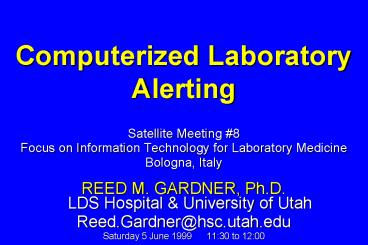Computerized Laboratory Alerting - PowerPoint PPT Presentation
1 / 29
Title:
Computerized Laboratory Alerting
Description:
... for reporting imminent life-threatening laboratory results or ... 3. Alert documentation is incomplete. Laboratory. Clinicians. Study of Critical Value ... – PowerPoint PPT presentation
Number of Views:394
Avg rating:3.0/5.0
Title: Computerized Laboratory Alerting
1
Computerized Laboratory Alerting
- Satellite Meeting 8
- Focus on Information Technology for Laboratory
Medicine - Bologna, Italy
- REED M. GARDNER, Ph.D.LDS Hospital University
of Utah - Reed.Gardner_at_hsc.utah.edu
- Saturday 5 June 1999 1130 to 1200
2
Transcribed Dictation
ICU/SURGERY
Nurse Care Plans
Pulse Oximeters
Infectious Disease
Nursing Procedure Charting
Ventilators
KNOWLEDGE DATABASE
Pharmacy
Mixed Venous Saturations
IV Pumps
ECG Lab
DECISION MAKING PROCESSOR, DATA AND TIME DRIVER
MIB Data
Bedside Monitors
INTEGRATED CLINICAL DATA BASE
Surgery Anesthesia Charting
Physiologic Data
X-Ray
Laboratory
Blood Gas Lab
Data Review Alerts Computations Interpretations Pr
otocols
Pathology
Surgery Schedule
Blood Bank
Admitting
Catherization
Medical Records
Respiratory Therapy
OUTPUT
3
(No Transcript)
4
Definition Critical Value
- A critical laboratory value represents a
pathophysiological state at such variance with
normal as to be life-threatening unless something
is done promptly and for which some corrective
action could be taken. - Lundberg GD Med Lab Observ 1972
5
Editorial Panic Value Notification
- Since failures of communication of important
pieces of information between people.are so
frequent, responsibility of the laboratory
person who first recognizes the vital information
to make certain the information is properly
communicated.. - Lundberg GD JAMA 1990
6
Critical Values ACAP Practice Parameter
- Appropriate use of critical values improves
patient outcome by ensuring the physicians are
promptly notified of immediate life-threatening
conditions. The best way to report
critical values are by telephone or by
alphanumeric pager. - Am J Clin Pathol 1997108247-253
7
Clinical Laboratory Improvement Act (CLIA) 1988
USA
- The laboratory must develop and follow written
procedures for reporting imminent
life-threatening laboratory results or panic
values. In addition, the laboratory must
immediately alert the individual or entity
requesting the test or the individual responsible
for utilizing the test results when any test
result indicates an imminent life-threatening
condition.
8
Current Weaknesses in the Critical Value
Reporting Process
- 1. Values are not always reported
- 2. Data are NOT usually reported to
primary clinicians - 3. Alert documentation is incomplete
- Laboratory
- Clinicians
9
Study of Critical ValueReporting at LDS
HospitalNov. 1992 - Feb. 1993
10
Men more frequently need to be reminded than
informed.
- Samuel Johnson
- 1770
11
(No Transcript)
12
Clinical Decision Making
- It is simply unrealistic to think that
individuals can synthesize in their heads scores
of pieces of evidence, accurately estimate the
outcomes of different options, and accurately
judge the desirability of those outcomes for
patients. - David M. Eddy, MD, PhD
- JAMA 1990 2631265-1275
13
Clinical Decision Making
- ...All confirm what would be expected from common
sense The complexity of modern medicine exceeds
the inherent limitations of the unaided human
mind. - David M. Eddy, MD, PhD
- JAMA 1990 2631265-1275
14
Expert Systems
- We dont need EXPERT systems!
- We need MEDIOCRE systems to prevent us from
making stupid mistakes. - Dean F. Sittig, PhD
- November 1990
15
How alerts usually works at LDS Hospital
- Laboratory test results are --
- Entered into laboratory computer
- Verified by lab personnel
- Transmitted to Clinical Computer System
- Stored in patient database
- Reviewed on bedside terminals
16
Then Critical Values Are
- Telephoned to floor
- Documented
- Time of call
- Person receiving call
- Stored in patient database
17
Critical Value Criteria(Patient-Specific)
18
Data on effectiveness of Nurse Pager computerized
critical value reporting(Oct. 23, 1993 to Jan
21, 1994)
19
Distribution of Acknowledgment Times(Oct. 23,
1993 to Jan. 21 1994)
20
Data on effectiveness of CLAS IIs Computerized
critical value reporting(Oct. 23, 1993 to Jan
21, 1994)
21
Data on effectiveness of CLAS IIs Computerized
critical value reporting(Oct. 23, 1993 to Jan
21, 1994)
22
Patient - Specific Criteria
- 92 (308/335) Judged valid (nurses)
- Verbal feedback positive
- No pattern for invalid alerts
- Encourages rapid acknowledgment
23
Comparison of Nurse Pager with other critical
value reporting systems
24
Alert Acknowledgment
- Ensures alert reception
- Allows documentation
- Uses computer terminal
- Can review lab data
- Can review other alerts
25
Advantages of a Computerized Critical Value
Reporting System
- All critical values reported
- Reported directly to primary nurse/physician
- Reported as soon as results are available
- Documentation is improved
- Can re-transmit alerts if necessary
- Integration with computerized care methods
26
Effective User Interface
- Feedback to clinicians
- Acknowledgment by clinicians
- Human factors
27
Other Design Issues
- Multiple critical values per lab test
- Patient discharges/transfers
- Successive lab tests-one patient
- Same results transmitted multiple times
- What if NO pager working
28
Conclusions
- CLAS II effective in reporting Critical Values
- Compares favorably to other systems
- Nurses not required to be at terminals
- Every critical value reported
- 76 of Critical Values to primary nurse
- Automatic documentation
29
(No Transcript)































